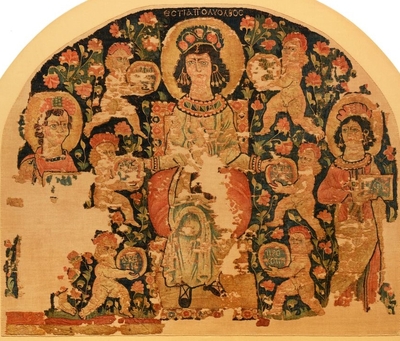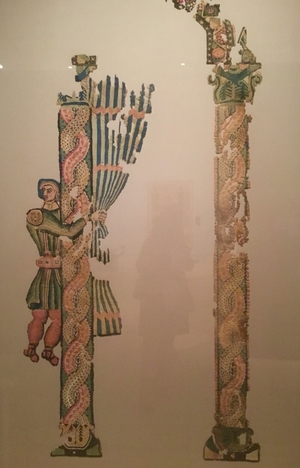Washington
Egypt's cultural heritage has captivated scholars for centuries, but it still poses puzzles, as two Washington institutions well know. The Textile Museum of George Washington University and the Dumbarton Oaks Research Library and Collection of Harvard University own many Egyptian textile fragments from the fourth to the 10th centuries. They are clearly household furnishings, but they were found in graves, reused as shrouds, divorced from their original context and lacking in documentation.
 "Woven Interiors: Furnishing Early Medieval Egypt," at the Textile Museum, presents about 50 of these rare and rarely displayed pieces from their collections and others. There's a multicolored, arched sixth-century wool tapestry portraying Hestia Polyolbus, the Greek goddess of the hearth; a small, striking fifth-century wool fragment of a wide-eyed, curly-haired, bearded, well-modeled male face (at left); and a large red-and-white fifth-century covering—its center entirely missing—that shows alternating rows of stylized, dancing men and women, arrayed in arcades.
"Woven Interiors: Furnishing Early Medieval Egypt," at the Textile Museum, presents about 50 of these rare and rarely displayed pieces from their collections and others. There's a multicolored, arched sixth-century wool tapestry portraying Hestia Polyolbus, the Greek goddess of the hearth; a small, striking fifth-century wool fragment of a wide-eyed, curly-haired, bearded, well-modeled male face (at left); and a large red-and-white fifth-century covering—its center entirely missing—that shows alternating rows of stylized, dancing men and women, arrayed in arcades.
How would they have been used in Egyptian homes and palaces of a millennium and more ago?
Drawing on technical evidence, physical features (like loops), iconographic traditions, and the contemporary literary and visual references (like mosaics) that do exist, curators Sumru Belger Krody of the Textile Museum and Elizabeth Dospěl Williams of Dumbarton Oaks have pieced together some answers. The hollowed-out fragment seems to be a bedspread or slipcover whose resting owner wore down the middle. "Hestia"—a portrait of the enthroned goddess in a garden setting, surrounded by naked boys carrying inscribed discs—was probably not, as previously thought, hung in an arched niche, used ceremonially and viewed from afar. After technical analysis, Ms. Williams believes it was part of a larger piece that hung in an atrium or the rooms of a private home.
 Hestia |
While it's difficult to visualize a typical Egyptian upper-class medieval home from such fragments, we know that they would have been spread throughout courtyard houses, which accommodated both living quarters and spaces for business and entertaining. Made by hand, often in workshops, they were precious possessions that added grandeur, comfort, color and warmth, with the most luxurious pieces filling the public spaces.
Many items here suggest that Egyptians had a literal bent, commissioning weavings that mimicked their architectural surroundings or purpose. A fourth- to fifth-century rug fragment with geometric patterns resembles a mosaic floor. A plush fifth- to sixth-century remnant of a male servant standing beneath an arch appears to be a screen hung to hide from visitors real servants at work. And a fifth- to sixth-century curtain, about 7½ feet long, shows two ornately decorated, free-floating columns with a mysterious free-floating head positioned above each one. Thinly woven, it was probably meant to be viewed from both sides and hung among actual columns in a courtyard, perhaps helping to direct the flow of air. Textiles also divided spaces and guided the path of visitors through the house.
 This deliberate match between design and function is keenly illustrated in the fifth-century "Hanging Depicting Ostiarius Drawing a Curtain." It (left) shows a servant in Roman attire and sandals standing beside an ornate, columned archway (most of the fruit-laden arch, alas, is missing). He pulls aside a blue-and-white striped curtain, as if to admit guests—signaling to those passing that they were crossing a threshold. That he is a servant, and likely a foreigner, is clear from the metal ring of indenture around his neck and his curly blond hair.
This deliberate match between design and function is keenly illustrated in the fifth-century "Hanging Depicting Ostiarius Drawing a Curtain." It (left) shows a servant in Roman attire and sandals standing beside an ornate, columned archway (most of the fruit-laden arch, alas, is missing). He pulls aside a blue-and-white striped curtain, as if to admit guests—signaling to those passing that they were crossing a threshold. That he is a servant, and likely a foreigner, is clear from the metal ring of indenture around his neck and his curly blond hair.
In the living quarters, the furnishings seemed to be softer and thicker. Comfort superseded the making of a statement about the owner's station in life (or aspirations). Judging from the remnants on view, though, the designs seem no less ambitious. One intricate fourth- to sixth-century hanging is busy with horses and their grooms outfitted in colorful Persian robes and leggings, set in a red background. A sixth- to seventh-century hanging nearby is equally dense with lions, panthers, horses and riders situated amid baskets and vines—also akin to Sasanian motifs. These pieces may, in fact, have come from Persia: The textiles on view were all discovered in Egypt, but not necessarily made there. International trade was thriving during these centuries.
As the curators of "Woven Interiors" readily admit, these fragile traces of life long ago still pose many unanswered questions. Displaying them gives visitors some sense of medieval Egyptian life, but it also challenges scholars to continue their quest for greater understanding of them.

